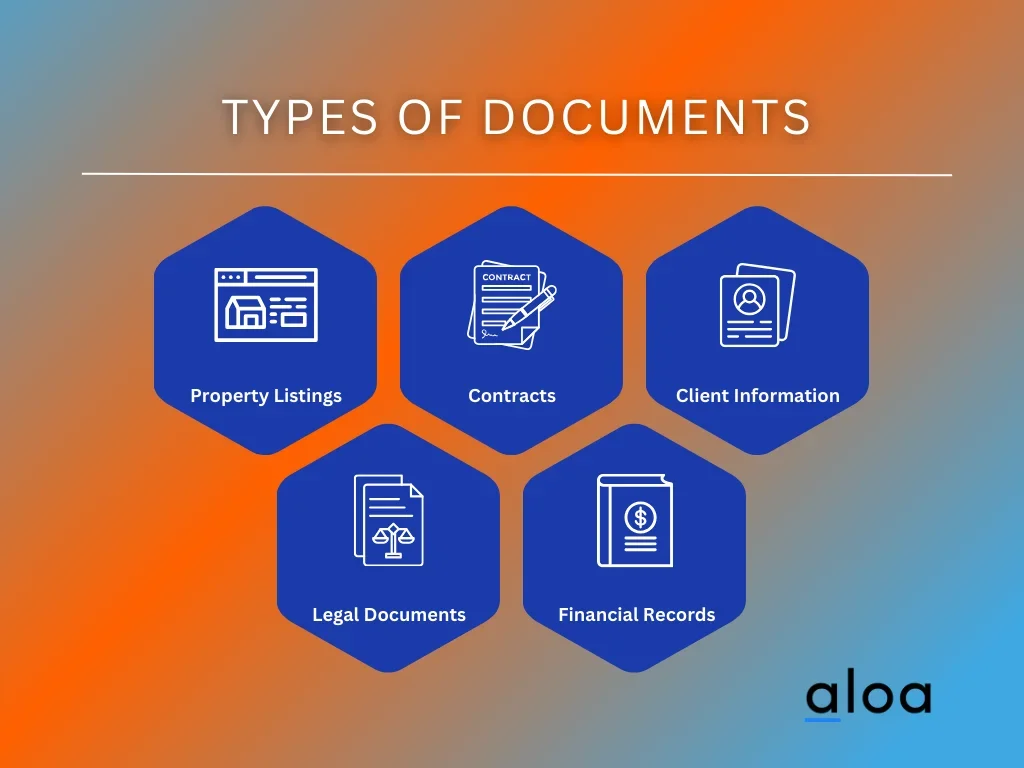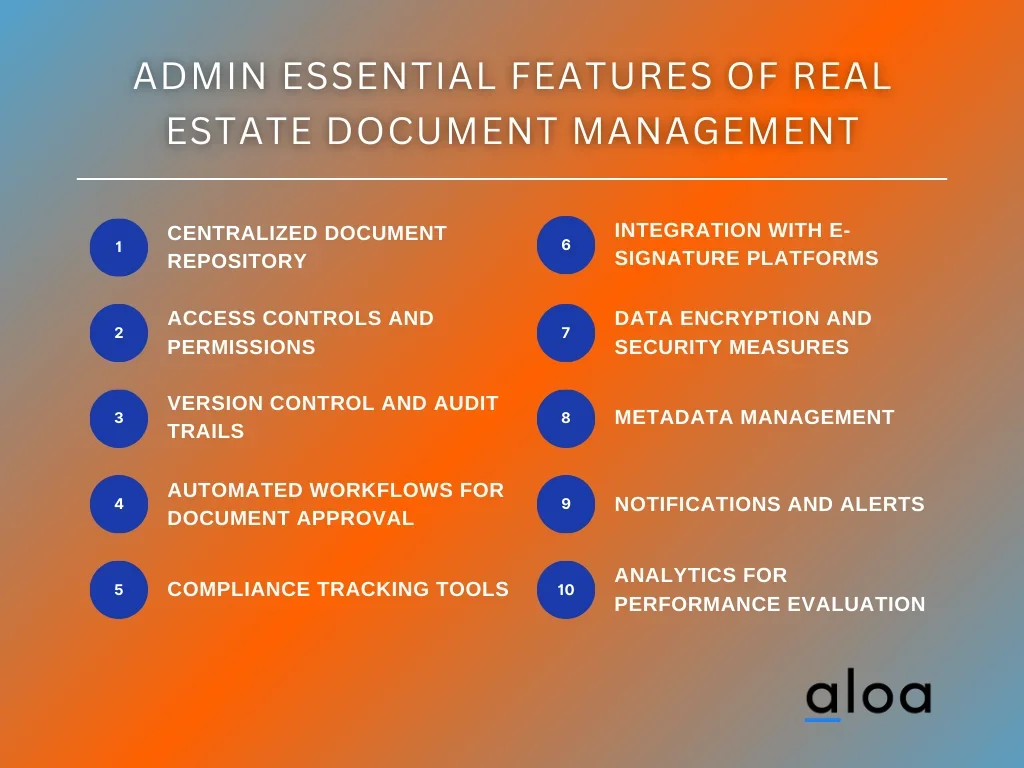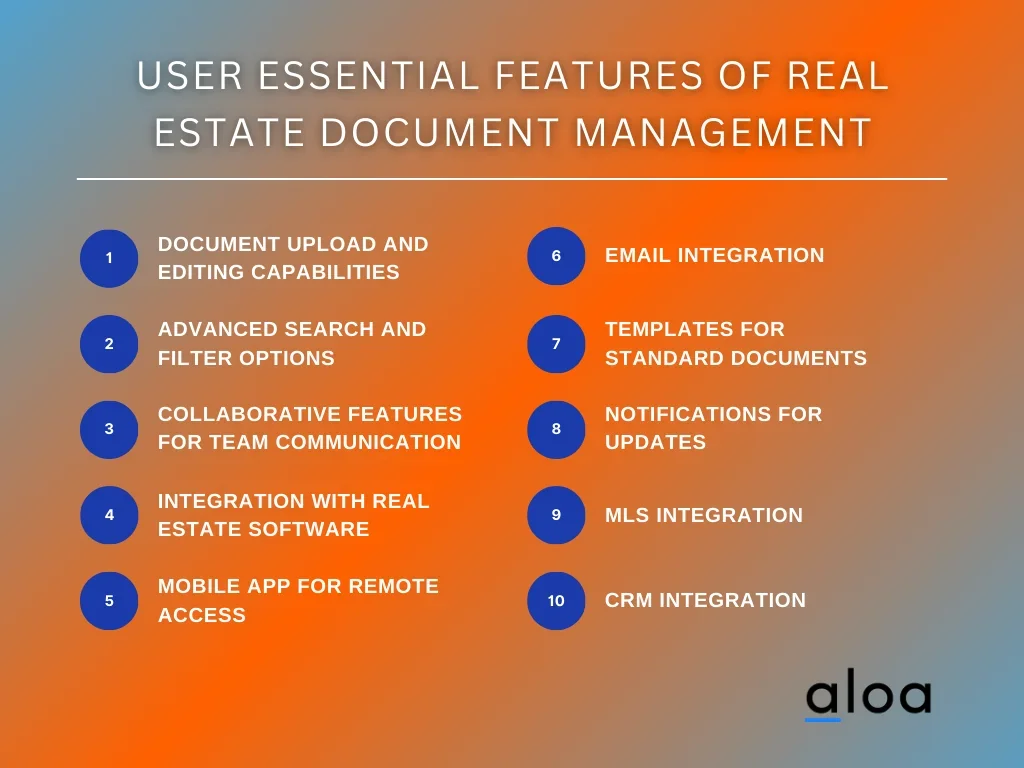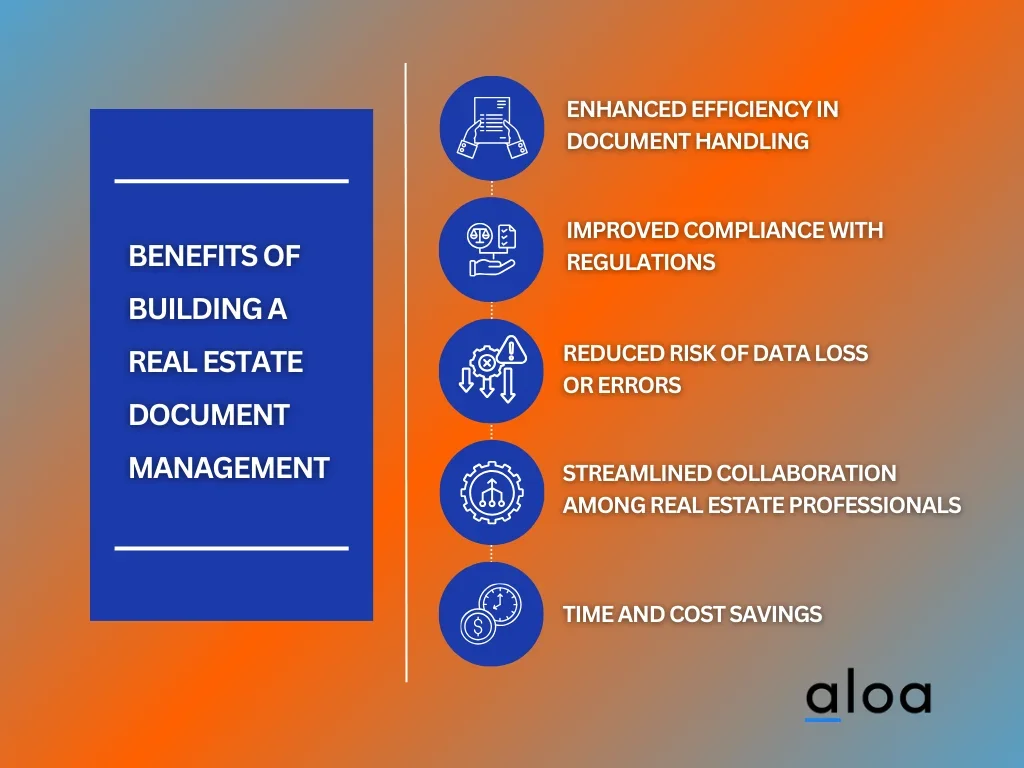Effective real estate document management is crucial for streamlining business processes and ensuring compliance with regulations. With a proper document management system, challenges such as misplaced paperwork, delayed transactions, and security vulnerabilities can maintain the overall efficiency of a real estate business. Businesses can enhance their document workflows, from filing paperwork to managing property records and real estate transactions.
Aloa, a fully managed service provider, specializes in guiding businesses and startups through these challenges. Offering valuable insights and tailored solutions, Aloa facilitates implementing real estate document management software, integrating seamlessly with existing tools. This ensures the secure handling of sensitive data points, including bank statements and disclosures, while providing a user-friendly interface for new agents.
This blog will explore the key steps and features necessary to build a customized real estate document management system. From defining specific requirements to integrating security measures, the blog provides a roadmap for businesses seeking to optimize their document management process. Afterward, you will understand how a REDMS can revolutionize your real estate business, improving overall efficiency and transaction management.
Let's jump in!
6 Steps to Build a Real Estate Document Management System
An efficient real estate document management system (REDMS) streamlines processes, ensuring seamless collaboration and regulatory compliance. Building a tailored REDMS involves a strategic process addressing specific industry needs. Each step contributes to a comprehensive solution, from defining requirements to implementing stringent security measures.
Let's delve into the six stages of crafting a tailored solution that optimizes document management in the real estate industry.

Step 1: Requirement Analysis
Conducting a thorough requirement analysis is paramount in the initial phase of building a real estate document management system (REDMS). Identifying the specific needs of your real estate business lays the foundation for a tailored and effective document management solution. This process involves meticulously examining your workflow, allowing you to pinpoint areas where document management can be optimized for maximum efficiency. For example, converting documents using Online Word to PDF tools can ensure consistency across platforms.
Types of Documents
Understanding the diverse documents integral to your real estate operations is crucial. This may encompass:

- Property Listings: Manage listings with details like location, price, and property features.
- Contracts: Handle various contracts, including sale agreements, lease agreements, and vendor contracts.
- Client Information: Securely store sensitive client data like personal details, communication logs, and transaction histories.
- Legal Documents: Manage legal paperwork, including property deeds, compliance documents, and litigation-related files.
- Financial Records: Organize financial documents such as invoices, receipts, and tax records.
Volume and Growth
Assessing the current volume of documents and anticipating future growth is a forward-looking aspect of the requirement analysis. Ensuring that the real estate document management system is scalable enables it to accommodate the increasing demands of your business, both in terms of document volume and additional features. This foresight guarantees that your document management system remains adaptable and practical as your real estate operations evolve.
Step 2: System Design
The critical decision in the system design phase is choosing between a cloud-based or on-premise software architecture. A cloud-based system offers flexibility, remote accessibility, and reduced need for physical infrastructure, making it ideal for businesses requiring mobility and scalability. On-premise solutions, on the other hand, provide greater control over data security and can be customized more extensively to specific business needs.
The system must also feature a user-friendly interface, ensuring ease of use for all skill levels. Simplified navigation, intuitive design, and clear labeling are essential for efficient document management. Furthermore, scalability is a priority; the system should be able to adapt and expand seamlessly with the business, accommodating an increasing number of documents and users without compromising performance or reliability.
Step 3: Security Planning
Ensuring the security of sensitive documents is crucial. Robust security measures should be implemented to safeguard valuable data and maintain the integrity and confidentiality of information. This step involves a comprehensive approach to fortifying your system against threats and unauthorized access.
- Sensitive Document Protection: Employ advanced encryption techniques to secure sensitive documents at rest and during transmission. Encryption adds an extra layer of protection, ensuring the information remains indecipherable even if unauthorized access occurs.
- User Authentication: Establish a robust user authentication system to verify the identity of individuals accessing the system. Multi-factor authentication (MFA) can be particularly effective, requiring users to provide multiple forms of identification, such as passwords and biometric data.
- Access Control: Develop and implement a comprehensive access control policy that dictates who can access specific documents and under what conditions. Regularly review and update access permissions based on personnel or organizational structure changes.
- Data Encryption: Utilize end-to-end encryption to protect data in transit, ensuring that information remains confidential during transmission between users and systems. This is particularly crucial for remote or mobile access to sensitive documents.
- Regular Security Audits: Conduct regular security audits to assess the effectiveness of existing security measures. These audits should include vulnerability assessments, penetration testing, and compliance checks.
By implementing these security measures, organizations can significantly reduce the risk of data breaches and unauthorized access to sensitive documents. A well-planned security strategy protects valuable information and instills confidence in users and stakeholders regarding the organization's commitment to data security and privacy.
Step 4: Development and Integration
Custom development offers tailored solutions aligned with specific needs, while customization of existing software ensures a more rapid and cost-effective implementation. Integration is another critical facet, enhancing the functionality of the REDMS by seamlessly connecting it with other essential tools. This includes Customer Relationship Management (CRM) systems and accounting software, creating a cohesive ecosystem that streamlines workflow and data management across various facets of real estate operations.
Consider partnering with Aloa as your development collaborator to elevate the REDMS creation process. With expertise in real estate software solutions, ensuring the tailored development or customization aligns seamlessly with your business objectives. Their proficiency can be instrumental in creating a comprehensive, efficient, and technologically advanced real estate document management system that caters specifically to the nuanced needs of your real estate business.
Step 5: Testing and Quality Assurance
Ensuring the reliability and effectiveness of your real estate document management system (REDMS) is essential. This step involves a meticulous approach to testing and quality assurance.
- Thorough Testing: Before the system is deployed, comprehensive testing is essential. This includes rigorous functionality evaluations to confirm that all features operate as intended. Usability testing ensures an intuitive interface, while security testing identifies and addresses vulnerabilities.
- User Feedback: Gathering feedback from potential users is a valuable aspect of the testing phase. User insights provide crucial perspectives on the system's usability, efficiency, and overall user experience.
- Compliance with Regulations: Regulatory compliance is non-negotiable, especially in sensitive information industries. Ensure your REDMS aligns with relevant regulations, such as GDPR or CCPA, to protect user data and maintain legal adherence.
By adhering to these considerations within the testing and quality assurance phase, you not only fortify the reliability of your REDMS but also position it to meet the highest standards of functionality, security, and user satisfaction in the dynamic landscape of real estate document management.
Step 6: Maintenance and Upgrades
The maintenance and upgrade phase of a real estate document management system (REDMS) is paramount to ensure its sustained efficiency and security. Regular updates are the cornerstone of this phase, incorporating new features to enhance functionality and implementing crucial security patches to fortify the system against evolving threats. This proactive approach bolsters the system's resilience and aligns it with the latest industry standards and best practices.
Periodic system audits and backups form the second pillar of this phase, offering a comprehensive strategy for risk mitigation. Audits identify potential vulnerabilities or inefficiencies, allowing for preemptive corrections. Simultaneously, robust backup procedures safeguard against data loss, providing a vital safety net in unforeseen incidents.
Staying attuned to technological advancements is the third tenet, ensuring that the REDMS remains at the forefront of innovation. Integrating emerging technologies as needed not only future-proofs the system but also positions it as a cutting-edge solution within the competitive landscape of real estate document management.
Essential Features of Real Estate Document Management
Efficient document management is crucial for success. A real estate document management system (REDMS) is pivotal in streamlining workflows, ensuring compliance, and enhancing collaboration. Below, we delve into the essential features of a robust REDMS, categorizing them for administrators and users.
Features for Admin
Administering a real estate document management system involves overseeing complex document handling, compliance, and security tasks. Here are ten crucial features tailored for administrators:

- Centralized Document Repository: A central repository allows admins to manage, organize, and store all documents in one location. This feature streamlines access, ensuring all stakeholders can effortlessly retrieve essential documents.
- Access Controls and Permissions: Admins can define access levels and permissions for different users within the system. This feature ensures that sensitive information is only accessible to authorized personnel, enhancing data security.
- Version Control and Audit Trails: Version control keeps track of document edits, alterations, and updates. Audit trails provide a comprehensive history of document activities, offering transparency and accountability.
- Automated Workflows for Document Approval: Admins can create automated workflows for document approval processes. This feature expedites decision-making, reduces delays, and enhances overall efficiency.
- Compliance Tracking Tools: Compliance tracking tools are indispensable to navigate the complex landscape of real estate regulations. Admins can monitor adherence to industry standards, mitigating risks associated with non-compliance.
- Integration with E-Signature Platforms: Seamless integration with e-signature platforms such as DocuSign ensures the legality and authenticity of digital signatures, expediting document approvals and transactions.
- Data Encryption and Security Measures: Implementing robust data encryption and security measures safeguard sensitive information against unauthorized access and potential data breaches.
- Metadata Management: Admins can attach metadata to documents, facilitating efficient system categorization, searchability, and retrieval of specific files.
- Notifications and Alerts: Real-time notifications and alerts inform admins about critical document-related activities, ensuring timely responses and proactive management.
- Analytics for Performance Evaluation: Incorporating analytics tools enables admins to assess system performance, user engagement, and document utilization, allowing continuous improvement.
Features for Users
For users navigating the REDMS, user-friendly features enhance document handling, collaboration, and productivity.

- Document Upload and Editing Capabilities: Users can easily upload, edit, and manage documents within the system, fostering collaborative efforts and minimizing reliance on external tools like Microsoft Word.
- Advanced Search and Filter Options: A user-friendly search interface with advanced filtering options accelerates document retrieval, enabling users to locate specific files quickly.
- Collaborative Features for Team Communication: In-built collaboration tools, such as commenting and real-time editing, facilitate seamless communication among team members, reducing reliance on external email platforms.
- Integration with Real Estate Software: Integration with popular real estate software like Yardi, MRI, or Hub enhances the overall functionality of the REDMS, creating a cohesive ecosystem for users.
- Mobile App for Remote Access: A mobile app ensures that users can access and manage documents on the go, catering to the dynamic nature of real estate transactions and property management.
- Email Integration: Users can integrate their email accounts with the REDMS, streamlining communication and allowing for direct document sharing through the platform.
- Templates for Standard Documents: Pre-built templates for standard real estate documents, such as leases and contracts, save users time and ensure consistency in documentation.
- Notifications for Updates: Users receive notifications for document updates, ensuring they stay informed about changes relevant to their tasks and responsibilities.
- MLS Integration: Integration with Multiple Listing Service (MLS) platforms allows real estate professionals to seamlessly access and share property listings within the REDMS.
- CRM Integration: Linking the REDMS with Customer Relationship Management (CRM) tools enhances client management and ensures that user interactions are well-documented.
Benefits of Building a Real Estate Document Management
A real estate document management system (REDMS) can stream operations and ensure seamless collaboration. Let's explore the key benefits of investing in and building a REDMS.

Enhanced Efficiency in Document Handling
A well-designed REDMS transforms the cumbersome document-handling process into a streamlined, digital workflow. Real estate professionals can quickly access, update, and share critical information by centralizing all documents in one secure repository. This efficiency boost significantly reduces the time spent on manual document searches and minimizes the risk of errors.
Improved Compliance with Regulations
The real estate industry operates within stringent regulations and compliance requirements. A REDMS offers a structured approach to meeting these standards by providing features such as version control, audit trails, and automated workflows. This ensures that all documents adhere to industry regulations, minimizing the risk of legal issues and fines.
Reduced Risk of Data Loss or Errors
In a fast-paced industry like real estate, the risk of data loss or errors can be high, mainly when relying on traditional, paper-based document management. A REDMS mitigates this risk by implementing secure storage, backup systems, and encryption protocols. Real estate professionals can rest assured that their critical documents are safe, even during unexpected events.
Streamlined Collaboration Among Real Estate Professionals
Successful real estate transactions often involve collaboration among multiple stakeholders, including agents, brokers, legal professionals, and clients. A REDMS fosters seamless collaboration by providing a centralized platform for sharing and editing documents. Features like real-time updates and collaborative tools enhance communication and ensure everyone involved is on the same page throughout the process.
Time and Cost Savings
Investing in a REDMS translates into tangible time and cost savings. The efficiency gains, reduced risk of errors, and streamlined collaboration all contribute to faster transaction cycles. Real estate professionals can allocate more time to revenue-generating activities, and organizations benefit from cost reductions associated with paper, printing, and manual administrative tasks.
Key Takeaway
Implementing a real estate document management system (REDMS) is crucial for streamlined operations in the real estate industry. Businesses should actively invest in a customized REDMS to ensure optimal results and enhance overall efficiency. The REDMS serves as a centralized repository for crucial documents, promoting accessibility and mitigating the risk of data loss or errors. With advanced features like version control, audit trails, and automated workflows, businesses can elevate their document-handling processes, ensuring compliance with industry regulations.
Investing in a real estate solution allows businesses to tailor the system to their specific needs in the residential, commercial, or specialized real estate sectors. The significance of this investment is underscored by the system's ability to facilitate collaboration among real estate professionals through user-friendly interfaces and mobile responsiveness. As businesses navigate the complexities of real estate transactions, a REDMS becomes an indispensable tool, providing document storage and a comprehensive solution for effective document management.
In conclusion, the proactive adoption of a real estate document management system is a strategic move that businesses in the real estate sector should prioritize. For more information and assistance implementing a customized REDMS, businesses are encouraged to contact [email protected].

